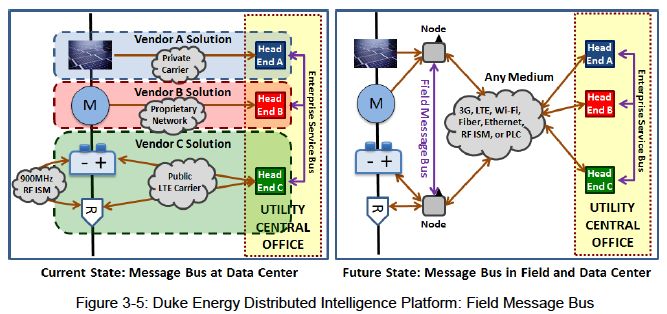The annual DistribuTech conference is the place to discover the latest advances in power grid technology — and catch up on long-running technology efforts that are finally starting to bear near-commercial fruit.
For the past six years, giant utility Duke Energy and a who’s-who list of corporate partners have been working on a technology known as an Open Field Message Bus, or OpenFMB. This standard is meant to allow smart meters, solar inverters, battery controllers, distribution grid control systems and communications network nodes to use their on-board computing power to solve edge-of-grid problems that happen too fast for centralized grid control systems to manage.
Duke and its growing list of OpenFMB partners have used the analogy of a “smartphone for the grid” to describe their long-range goal. It’s an analogy that’s caught on in the utility industry, which has long relied on specialized, largely proprietary technologies, but is seeking to capture the advantages of the latest advances in IT.
Duke launched its efforts in 2013 at its Charlotte, N.C. smart grid test bed, working with six partners — Accenture, Alstom, Ambient, Echelon, S&C Electric and Verizon — in a group it dubbed the "Coalition of the Willing." At the 2015 DistribuTech conference, Duke announced the expansion of its coalition to 25 corporate partners, added utilities Southern California Edison and CPS Energy to its partner list, opened a second field test of the technology at its Mount Holly, N.C. microgrid test bed, and published the first OpenFMB reference architecture.
The OpenFMB effort was then taken up by the Smart Grid Interoperability Panel industry organization, which merged with the Smart Electric Power Alliance in 2017. Last year, SEPA transferred OpenFMB development to the Utility Communications Architecture International Users Group, the next necessary stage in moving toward commercialization of the standard.
Commercial-grade device demoed at DTech
On Tuesday, the opening day of this year’s DistribuTech in New Orleans, Duke and OpenFMB partner Sierra Wireless announced the first step toward delivering the first commercial-grade device built to run the standard — a “next-generation intelligent edge platform to run more complex, centrally managed and containerized edge applications.”
Specifically, Sierra has made several hardware changes to its AirLink MP70 cellular gateways, a commonly used piece of equipment for utility SCADA systems, to allow them to support OpenFMB capabilities in the future. Those include doubling the on-board memory, incorporating Sierra’s GPS precision time and location capabilities, and incorporating “containerized software” capabilities that can allow utilities to run multiple software applications on the gateways, while also maintaining the security of critical grid operations over the same device.
“We are demonstrating near-commercial product,” Tom Mueller, vice president of enterprise solutions product for Sierra Wireless, said in an interview. “It’s product that is shipping today, has been shipping for a number of years, onto which we’ve made enhancements that will come in future releases.”
Duke and Sierra haven’t announced any commercial relationships around Tuesday’s product announcement. But Stuart Laval, Duke’s director of technology development, noted that the underlying capabilities of Sierra’s new gateway fit into Duke’s plans for deploying grid communications technology that can support distributed intelligence and edge processing.
“This is a cellular gateway product that can essentially communicate with any asset,” he said. “It’s not AMI, and it’s not smart cities."
Duke is already deploying advanced metering infrastructure (AMI) with partner Itron, and has smart city infrastructure deployed as part of an initiative in its headquarters' city of Charlotte, N.C. “But it’s pretty much every other type of grid edge communications," said Laval.
While the hardware capabilities of Sierra’s new gateway are in line with the latest 4G and emerging 5G technologies coming from the industry at large, its software capabilities are new, he added. “OpenFMB is more of an interoperability framework. It enables distributed intelligence.”
Solving DER problems
In particular, Duke and its OpenFMB partners are trying to solve the problem of how to coordinate hundreds, thousands or even more individual rooftop solar PV systems, behind-the-meter batteries, plug-in electric vehicles, responsive building energy loads, and other grid-edge systems to work in real time with the utility smart grid platforms they’re connected to.
Centralized utility control systems can’t communicate and process this edge-of-network data fast enough to coordinate responses to the kind of problems these distributed energy resources (DERs) can create, such as surges and sags in voltage as clouds pass over large solar arrays. But if they’re able to share the data processing and decision-making tasks at the edge, then they can — if, that is, they’re secure and reliable enough to be trusted to do the tasks.

Mueller highlighted the importance of Sierra’s use of “containerization” to maintain the security of critical grid operations on a device that could also be running multiple software applications from multiple vendors. Duke and Sierra have partnered with Open Energy Solutions Inc., a Santa Clara, Calif.-based company created by Japanese industrial and trading giant Itochu Corp., to provide the open-source platform to enable this.
Duke and Pacific Northwest utility Avista, another OpenFMB partner, made a joint investment into Open Energy Solutions earlier this month to support that development. OES’ CEO is Wade Malcolm, the former head of Omnetric Group, the joint venture of Siemens and Accenture, two big partners on Duke’s OpenFMB projects.
Duke has been expanding its OpenFMB tests to involve several U.S. Department of Energy national laboratories. Last year, DOE awarded a $6 million grant to Duke, Avista, GE Grid Solutions, SEPA, and the Pacific Northwest National Laboratory, Oak Ridge National Laboratory and the National Renewable Energy Laboratory to field-test OpenFMB’s ability to coordinate networks of DERs and microgrids. The partners are now close to installing the technology in a community-center microgrid in Anderson, S.C.
Visit Greentech Media and Wood Mackenzie at DistribuTECH (Booth 10357).




